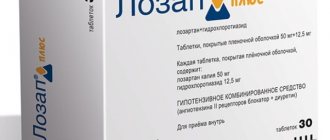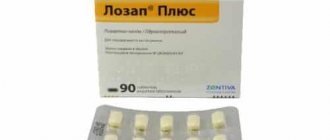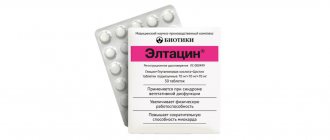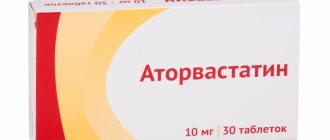Pharmacological properties of the drug Lozap
Losartan is a specific antagonist of the receptor (AT1 type) of angiotensin II. Angiotensin II binds to the AT1 receptor, which is found in many tissues (eg vascular smooth muscle, adrenal glands, kidneys and heart). Losartan and its pharmacologically active metabolite carboxylic acid (E-3174) block the effects of angiotensin II. Losartan does not bind or block other hormone receptors and ion channels important for cardiovascular regulation. Losartan does not inhibit ACE, but blocks the response to angiotensin I and II and has no effect on the kinin system or bradykinin levels. Losartan has no effect on autonomic reflexes and the level of norepinephrine in the blood plasma. The drug is equally effective in men, women under 65 years of age and in elderly and senile patients with hypertension (arterial hypertension). With simultaneous use of Lozap with thiazide-type diuretics, the degree of blood pressure reduction increases. After oral administration, losartan is well absorbed and, as a result of metabolism during the initial passage through the liver, an active metabolite of carboxylic acid and inactive metabolites are formed. Systemic bioavailability after oral administration of losartan is about 33%. The average maximum concentration of losartan is achieved within 1 hour, and its active metabolite - within 3-4 hours. When using the drug with a standardized diet, no clinically significant effect on the profile of the concentration of losartan in the blood plasma was noted. Plasma clearance for losartan and its active metabolite is approximately 600 and 50 ml/min, respectively. The renal clearance of losartan and its active metabolite is about 74 and 26 ml/min, respectively. After oral administration, almost 4% of the dose is excreted unchanged in the urine and about 6% of the dose as an active metabolite. With oral administration of losartan potassium in doses up to 200 mg, the pharmacokinetics of the drug and its active metabolite are linear. After oral administration, the concentration of the drug and its active metabolite in the blood plasma decreases polyexponentially with a final half-life of 2 hours for losartan and 6–9 hours for the active metabolite. At a single daily dose of 100 mg, neither losartan nor its active metabolite accumulates in the blood plasma in significant quantities.
Therapeutic properties
Indications for the use of the drug "Lozap" are different. The drug will allow:
- Reduce blood pressure and keep it normal.
- Reduce the load on the heart.
- Reduce the amount of aldosterone and adrenaline in the blood.
- Increase tolerance to physical and emotional stress in people with cardiovascular diseases.
- Improve cardiac circulation and renal blood flow intensity.
A moderate diuretic effect is also possible from taking the drug.
Within a few hours you can notice the first positive effect from taking the capsule. It will keep throughout the day. For a sustained reduction in blood pressure, the therapeutic course should be 1 month.
The drug is particularly effective in treating those with malignant arterial hypertension.
“Lozap Plus”, in addition to the described therapeutic actions, produces additional:
- Helps reduce the concentration of potassium in the blood.
- Activates the production of the hormone renin.
- Reduces the concentration of uric acid and accelerates its elimination.
The active substances of the drugs are perfectly absorbed by the body and quickly enter the bloodstream from the gastrointestinal tract.
Indications for use of the drug Lozap
Lozap : hypertension (arterial hypertension); reducing the risk of cardiovascular complications and mortality in patients with hypertension (arterial hypertension) and left ventricular hypertrophy; protection of kidney function with type II diabetes mellitus with proteinuria in order to slow the progression of kidney disease (preventing the need for dialysis and kidney transplantation), as well as to reduce proteinuria; chronic heart failure, if therapy with ACE inhibitors is inappropriate. Lozap Plus : hypertension (arterial hypertension) (patients for whom combination therapy is indicated); reducing the risk of developing cardiovascular complications and mortality in patients with hypertension (arterial hypertension) and left ventricular hypertrophy.
general description
Is as follows:
| Drug/Features | "Lozap" | "Lozap plus" |
| Release forms | Pills | Pills |
| Dosage | 12.5 mg | 62.5 mg |
| 500 mg | ||
| 100 mg | ||
| Appearance | An oblong, biconvex white tablet. A cardboard pack contains 30, 60 or 90 capsules | An oblong shape of a light yellow hue with a transverse dash. The package may contain 10, 20, 30 or 90 pills |
Use of the drug Lozap
For hypertension (arterial hypertension), the initial and maintenance dose is 50 mg 1 time per day. The maximum antihypertensive effect is achieved 3–6 weeks after the start of administration. In some cases, to achieve a greater effect, the dose is increased to 100 mg once a day. When prescribing the drug to patients with reduced intravascular volume (for example, receiving diuretics in high doses), a lower initial dose is recommended - 25 mg 1 time per day. No dose adjustment is required in elderly patients or patients with impaired renal function, including patients on dialysis. Patients with impaired liver function should be prescribed Lozap at a lower dose. The starting dose for patients with chronic heart failure is 12.5 mg once daily. In the future, the dose should be titrated, as a rule, gradually increasing it every week by 12.5 mg / day (i.e. 12.5; 25; 50 mg / day), reaching an average maintenance dose of 50 mg 1 time per day, depending on tolerability drug. The titration period is determined taking into account individual tolerability of treatment. The drug is taken regardless of meals; The tablet is swallowed without chewing, washed down with water.
Composition and release form
The drug Lozap is available in the form of small tablets for parenteral administration. They are white, slightly elongated and convex on both sides. They have a soluble thin film shell. Packaged in blisters of 10 pieces. One cardboard package contains 3, 6, 9 blisters and includes instructions for use.
The active substance is potassium losartran.
Auxiliary components: cellulose, povidone, talc, magnesium stearate, macrogol, dyes, mannitol, croscarmellose sodium.
Side effects of the drug Lozap
May occur in the form of anaphylactic reactions, angioedema, including swelling of the larynx and glottis, with the development of airway obstruction and/or swelling of the face, lips, pharynx and/or tongue. In controlled clinical trials, the only side effects were dizziness and hypotension. In some cases, patients receiving losartan experienced hepatitis, diarrhea, impaired liver function, migraine, myalgia, arthralgia, urticaria, and itching. Adverse reactions from the respiratory tract have been described: cough, upper respiratory tract infections. When treated with losartan, a dry cough is detected.
Side effects
As a rule, during the course of therapy, patients experience virtually no side effects. If they appear, they go away on their own and quickly, so there is no need to discontinue the drug. The following side effects are possible when taking Lozap:
- Dizziness, increased fatigue, headache, problems falling asleep. Migraines, anxiety, tremor, and depression are less common.
- Infection of the respiratory system. Signs of rhinitis, bronchitis and respiratory distress may appear.
- Dyspeptic symptoms, rarely gastritis, dry mouth, flatulence.
- Disturbance of the musculoskeletal system. Possible pain in the back and muscles, cramps.
- Signs of cardiac dysfunction are expressed in tachycardia, bradycardia, arrhythmia.
- Rarely, kidney problems, sexual dysfunction and infections of the urinary system appear.
- Allergic reactions, dry dermis, excessive sweating.
Special instructions for the use of the drug Lozap
Therapy with Lozap is not prescribed to patients with a deficiency of intravascular fluid volume (for example, patients receiving diuretics in high doses). If you have a history of liver disease, you should consider using the drug at a lower dose. In the presence of acute or chronic renal failure, the drug may lead to deterioration of renal function with or without hyperkalemia. Lozap should be used with caution in patients with bilateral renal artery stenosis or renal artery stenosis of a solitary kidney. Clinical studies have not revealed age-related differences regarding the effectiveness or safety of the drug. The use of the drug may negatively affect activities that require a high speed of mental and physical reactions (for example, when driving vehicles, servicing machines and mechanisms, working at heights, etc.).
Combination with other drugs
Interaction with other antihypertensive medications leads to an enhanced therapeutic effect. “Lozap” and “Lozap plus” can be combined with other drugs for the treatment of hypertension and heart failure.
Taking Lozapa Plus together with potassium-sparing diuretics is undesirable, as hyperkalemia may occur.
Not everyone knows the difference between Lozap and Lozapa Plus. Both described drugs are prohibited from being combined with alcohol, since such a combination can lead to a decrease in blood pressure. In this case, the person will experience nausea, vomiting, dizziness, numbness of the limbs, and impaired coordination of movements. He may feel generally unwell.
If taking Lozapa Plus is combined with drinking alcoholic beverages, you may notice a decrease in the therapeutic effect of the drug. It contains a diuretic component. When combined with alcohol, urination increases, and accordingly, the concentration of the active substance decreases.
If the patient has previously had angioedema, then throughout the entire therapy with the described drugs, medical supervision should be exercised, since a relapse of a severe allergic reaction is possible.
If a patient is diagnosed with hypovolemia or hyponatremia, caused by various factors, then hypotension may develop when taking Lozap and Lozap plus. If these disorders are present, before starting therapy with the described drugs, it is necessary to eliminate disturbances in the water-electrolyte balance or take both drugs in minimal dosages.
Drug interactions Lozap
In clinical and pharmacological studies, no clinically significant interactions were observed with hydrochlorothiazide, digoxin, warfarin, cimetidine, phenobarbital, ketoconazole and erythromycin. Rifampicin and fluconazole reduce the level of the active metabolite of losartan. The clinical consequences of these interactions have not been assessed. Strengthens (mutually) the effect of other antihypertensive drugs (diuretics, β-adrenergic receptor blockers, sympatholytics, other drugs that block ACE). Increases the risk of hyperkalemia when combined with potassium-sparing diuretics (for example, spironolactone, triamterene, amiloride) and drugs containing potassium or its salts. NSAIDs, including selective COX-2 inhibitors, reduce the effect of diuretics and other antihypertensive drugs. Therefore, the antihypertensive effect of ACE II receptor antagonists may be reduced by NSAIDs, including COX-2 inhibitors. The severity of the hypotensive effect of losartan, like other antihypertensive drugs, can be reduced with the help of indomethacin.
Analogs and other data
Among the analogues there are other drugs based on losartan, as well as other drugs from the corresponding pharmacological group:
| A drug | Compound | Price, rubles |
| Losartan | Losartan | 50 |
| Lorista | Losartan | 150 |
| Presartan | Losartan | 160 |
| Valsartan | Valsartan | 200 |
| Telmisartan | Telmisartan | 280 |
Lozap can be used with other drugs that have antihypertensive effects. Especially often in the prescriptions of cardiologists, Lozap appears together with beta blockers and sympatholytics. An additive effect (the total effect of drugs) is observed when taken with diuretics; the results in the treatment of hypertension will be more pronounced. Lozap does not interact with coagulants, Ketoconazole, prescription sedatives, or macrolides. But Fluconazole and Rifampicin reduce the amount of active metabolites of losartan in plasma. The risk of hyperkalemia increases when Lozap is used concomitantly with potassium-sparing diuretics.
Lozap overdose, symptoms and treatment
In case of overdose (intoxication) of the drug, symptoms such as hypotension, tachycardia may appear, and sometimes bradycardia may occur due to parasympathetic (vagal) stimulation. If symptomatic hypotension occurs, maintenance therapy is provided. In case of accidental overdose (taking the drug in a high dose), it is necessary to carry out symptomatic and supportive therapy, induce vomiting and gastric lavage. Neither losartan nor its active metabolite can be removed by hemodialysis.










